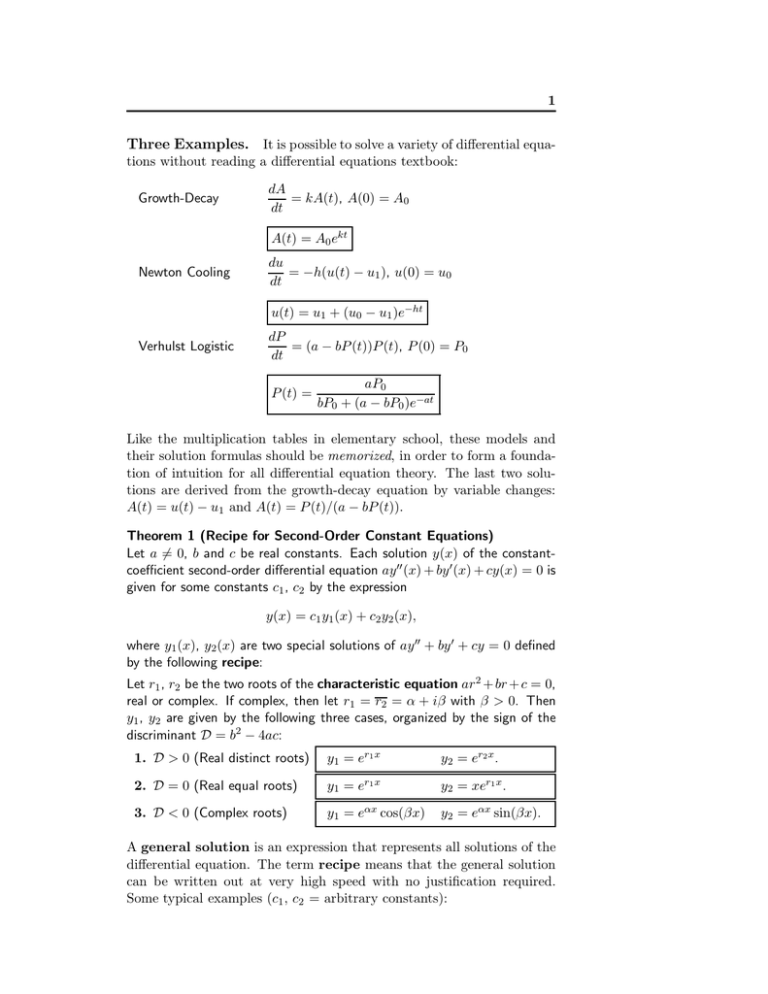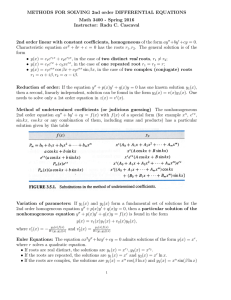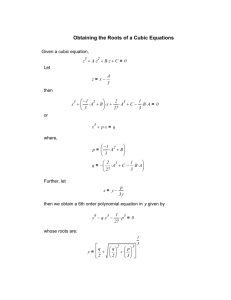Three Examples.
advertisement

1 Three Examples. It is possible to solve a variety of differential equations without reading a differential equations textbook: Growth-Decay dA = kA(t), A(0) = A0 dt A(t) = A0 ekt Newton Cooling du = −h(u(t) − u1 ), u(0) = u0 dt u(t) = u1 + (u0 − u1 )e−ht Verhulst Logistic dP = (a − bP (t))P (t), P (0) = P0 dt P (t) = aP0 bP0 + (a − bP0 )e−at Like the multiplication tables in elementary school, these models and their solution formulas should be memorized, in order to form a foundation of intuition for all differential equation theory. The last two solutions are derived from the growth-decay equation by variable changes: A(t) = u(t) − u1 and A(t) = P (t)/(a − bP (t)). Theorem 1 (Recipe for Second-Order Constant Equations) Let a 6= 0, b and c be real constants. Each solution y(x) of the constantcoefficient second-order differential equation ay 00 (x) + by 0 (x) + cy(x) = 0 is given for some constants c1 , c2 by the expression y(x) = c1 y1 (x) + c2 y2 (x), where y1 (x), y2 (x) are two special solutions of ay 00 + by 0 + cy = 0 defined by the following recipe: Let r1 , r2 be the two roots of the characteristic equation ar 2 + br + c = 0, real or complex. If complex, then let r1 = r2 = α + iβ with β > 0. Then y1 , y2 are given by the following three cases, organized by the sign of the discriminant D = b2 − 4ac: 1. D > 0 (Real distinct roots) y1 = er1 x y2 = er2 x . 2. D = 0 (Real equal roots) y1 = er1 x y2 = xer1 x . 3. D < 0 (Complex roots) y1 = eαx cos(βx) y2 = eαx sin(βx). A general solution is an expression that represents all solutions of the differential equation. The term recipe means that the general solution can be written out at very high speed with no justification required. Some typical examples (c1 , c2 = arbitrary constants): 2 Distinct real roots Equal real roots Complex conjugate roots λ1 = 5, λ2 = 2 λ1 = λ2 = 2 + 3i λ1 = 3, λ2 = 3 y = c1 e5x + c2 e2x y = c1 e3x + c2 xe3x y = c1 e2x cos 3x + c2 e2x sin 3x Solving planar systems x0 (t) = Ax(t). A 2×2 real system x0 (t) = Ax(t) can be solved in terms of the roots of the characteristic equation det(A − λI) = 0 and the real matrix A. The practical formulas are the analog of the recipe for second order equations with constant coefficients. Theorem 2 (Planar Constant-Coefficient Linear system) Consider the real planar system ~x0 (t) = A~x(t). Let λ1 , λ2 be the roots of the characteristic equation det(A − λI) = 0. The real general solution ~x(t) is given by the formulae Distinct real roots λ1 6= λ2 Equal real roots λ1 = λ2 Complex conjugate roots λ1 = λ2 = α + iβ, β > 0 ~x = ~ u1 eλ1 t + ~u2 eλ2 t ~x = ~u1 eλ1 t + ~u2 teλ1 t ~x = ~u1 eαt cos βt + ~u2 eαt sin βt ~u1 =~x(0) ~u1 =~x(0) ~u2 = (A − λ1 I)~x(0) 1 ~u2 = (A − αI)~x(0) β A − λ2 I ~x(0) λ1 − λ2 A − λ1 I ~x(0) ~u2 = λ2 − λ1 ~u1 = Illustrations. Typical cases are represented by the following 2 × 2 matrices A: λ1 = 5, λ2 = 2 A= ! −1 3 −6 8 λ1 = λ2 = 3 A= ~x(t) = ! ! −1 1 2 −1 ~x(0)e5t + ~x(0)e2t . −2 2 2 −1 Real double root. ! 2 1 −1 4 λ1 = λ2 = 2 + 3i A= Real distinct roots. ! 2 3 −3 2 ! −1 1 ~x(t) = ~x(0)e3t + ~x(0)te3t . −1 1 Complex conjugate roots. ~x(t) = = ~x(0)e2t ! 0 1 ~x(0)e2t sin 3t cos 3t + −1 0 ! cos 3t sin 3t ~x(0)e2t . − sin 3t cos 3t






